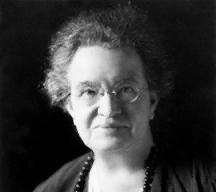Notable Women in Science
 Hypatia (310?-415) was the first woman scientist known by name and one of the last great ancient mathematicians. Hypatia studied science at a time when it was considered a danger to Christianity. She was murdered by a mob that objected to scientific study.
Hypatia (310?-415) was the first woman scientist known by name and one of the last great ancient mathematicians. Hypatia studied science at a time when it was considered a danger to Christianity. She was murdered by a mob that objected to scientific study.
 St. Hildegard of Bingen (1098-1179) took an interest in both the natural and supernatural worlds. She published nine volumes on the use of plants, animals, and metals in medicine.
St. Hildegard of Bingen (1098-1179) took an interest in both the natural and supernatural worlds. She published nine volumes on the use of plants, animals, and metals in medicine.
 Marie Curie (1867-1934) won the Nobel Prize twice in her lifetime for her pioneering work with radioactivity and radium.
Marie Curie (1867-1934) won the Nobel Prize twice in her lifetime for her pioneering work with radioactivity and radium.
 Florence Rena Sabin (1871-1953) was the first woman to be elected to the National Academy of Sciences. Her career focused on tuberculosis but when she retired, she continued to work for better sanitation laws.
Florence Rena Sabin (1871-1953) was the first woman to be elected to the National Academy of Sciences. Her career focused on tuberculosis but when she retired, she continued to work for better sanitation laws.
 Maria Goeppert Mayer (1906-1972) won the Nobel Prize for Physics in 1963 for her work on the shell theory of atomic structure.
Maria Goeppert Mayer (1906-1972) won the Nobel Prize for Physics in 1963 for her work on the shell theory of atomic structure.
 Dorothy Crowfoot Hodgkin (1910-1994) received the 1964 Nobel Prize for research about the structure of penicillin to control pernicious anemia.
Dorothy Crowfoot Hodgkin (1910-1994) received the 1964 Nobel Prize for research about the structure of penicillin to control pernicious anemia.
 Edith Hinckley Quimby (1891-1982) discovered the use of radiation in the treatment of cancer. She is often called "America's Madame Curie."
Edith Hinckley Quimby (1891-1982) discovered the use of radiation in the treatment of cancer. She is often called "America's Madame Curie."
 Jane Goodall (1934- ) studied the behavior of chimpanzees in the wild and discovered that humans are not the only toolmakers.
Jane Goodall (1934- ) studied the behavior of chimpanzees in the wild and discovered that humans are not the only toolmakers.


 Hypatia (310?-415) was the first woman scientist known by name and one of the last great ancient mathematicians. Hypatia studied science at a time when it was considered a danger to Christianity. She was murdered by a mob that objected to scientific study.
Hypatia (310?-415) was the first woman scientist known by name and one of the last great ancient mathematicians. Hypatia studied science at a time when it was considered a danger to Christianity. She was murdered by a mob that objected to scientific study. St. Hildegard of Bingen (1098-1179) took an interest in both the natural and supernatural worlds. She published nine volumes on the use of plants, animals, and metals in medicine.
St. Hildegard of Bingen (1098-1179) took an interest in both the natural and supernatural worlds. She published nine volumes on the use of plants, animals, and metals in medicine. Marie Curie (1867-1934) won the Nobel Prize twice in her lifetime for her pioneering work with radioactivity and radium.
Marie Curie (1867-1934) won the Nobel Prize twice in her lifetime for her pioneering work with radioactivity and radium. Florence Rena Sabin (1871-1953) was the first woman to be elected to the National Academy of Sciences. Her career focused on tuberculosis but when she retired, she continued to work for better sanitation laws.
Florence Rena Sabin (1871-1953) was the first woman to be elected to the National Academy of Sciences. Her career focused on tuberculosis but when she retired, she continued to work for better sanitation laws. Maria Goeppert Mayer (1906-1972) won the Nobel Prize for Physics in 1963 for her work on the shell theory of atomic structure.
Maria Goeppert Mayer (1906-1972) won the Nobel Prize for Physics in 1963 for her work on the shell theory of atomic structure. Dorothy Crowfoot Hodgkin (1910-1994) received the 1964 Nobel Prize for research about the structure of penicillin to control pernicious anemia.
Dorothy Crowfoot Hodgkin (1910-1994) received the 1964 Nobel Prize for research about the structure of penicillin to control pernicious anemia. Edith Hinckley Quimby (1891-1982) discovered the use of radiation in the treatment of cancer. She is often called "America's Madame Curie."
Edith Hinckley Quimby (1891-1982) discovered the use of radiation in the treatment of cancer. She is often called "America's Madame Curie." Jane Goodall (1934- ) studied the behavior of chimpanzees in the wild and discovered that humans are not the only toolmakers.
Jane Goodall (1934- ) studied the behavior of chimpanzees in the wild and discovered that humans are not the only toolmakers.

